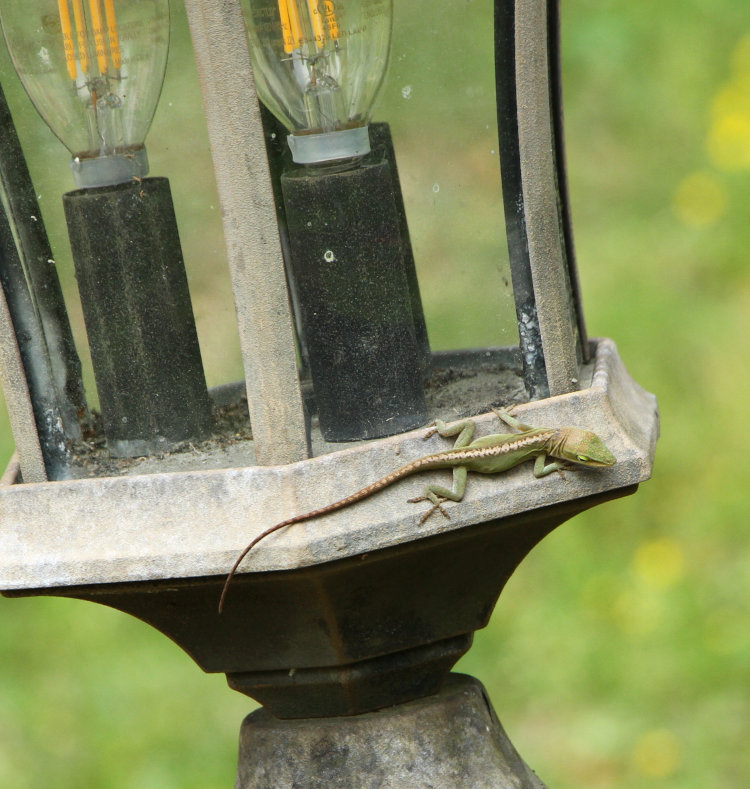
While trying to catch up with the backlog, naturally enough I went out yesterday and added quite a few photos to the queue, under a couple of different topics – one step forward, two back and all that. This post may help alleviate it a bit though, because it had more photos (and some brief video) dedicated to it than any other topic until yesterday, and so we return to the Carolina anoles (Anolis carolinensis,) since they actually own the property and are simply allowing us to live here, as long as we pay the mortgage and taxes and so on.
The lamp post out front (which has just been replaced, an act that may well get us evicted) has been a huge favorite of the species, almost as popular as the south side of the screened porch; once the temperatures topped 10°c and the sun was out, so were they, but a distinct addition occurred about a month ago.
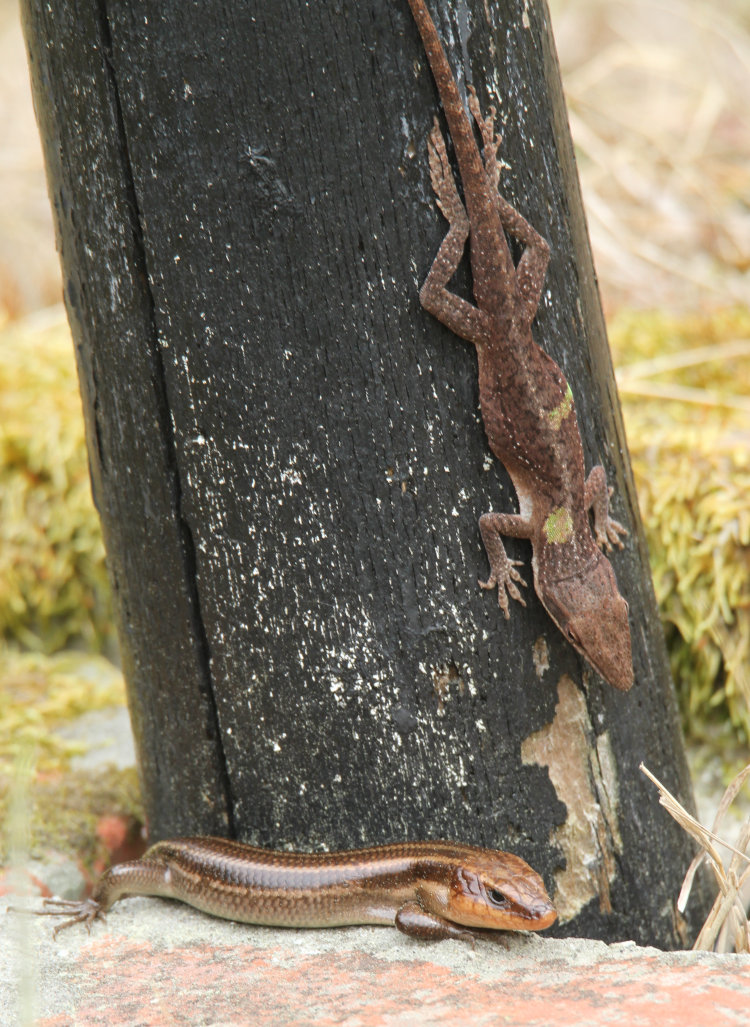
That’s an anole on the post, presently brown though that can change in mere seconds, with a female American five-lined skink (Plestiodon fasciatus) on the bricks at the base; the two species inhabit the same regions but have slightly different habits, the skinks being more terrestrial and only occasionally climbing, while the anoles spend little time on the ground itself. There’s a fair amount of crossover, but overall, you’re far more likely to see them like this: the anole vertical, the skink horizontal. Notice that there are a couple of green patches on the anole’s body, evidence only of something blocking the direct sunlight from the skin moments before, failing to trigger the biological system that causes the skin to turn into a more heat-absorbing brown. The skinks, however, only change color with maturity, though it’s different colors for the males and females.
Now we start to see the difference:

Notice how, only a minute later, one of the green patches has changed over to brown with the exposure to direct sunlight, though the other is lagging behind a little. It had changed soon afterward, though.

Now we have confirmed that the anole is male, since he is displaying his dewlap, that big pink thing under his chin. This serves two purposes: as a territorial display and as a mating display. While the skink is right there (and female,) it is unlikely that this display, whichever it is, is intended for the skink. They’re already too close together for it to be likely territorial, plus they’ve been this close for some time without it, and the anole isn’t going to try and seduce a skink. What I’m guessing, though I didn’t directly witness it, is that there was a female anole someplace nearby, since the post environs has numerous places where the anoles can be sitting without easily being observed.
We can see the subtle variation in the different displays in a couple of clips:
One thing not mentioned in there is that during contentious territorial disputes, actual fights between males, they display brighter colors and very distinct dark patches on the cheeks, like that seen here.
The skink made several appearances, but was always quite shy and would disappear at most close approaches, so it took me a little while to get a more direct portrait of her.
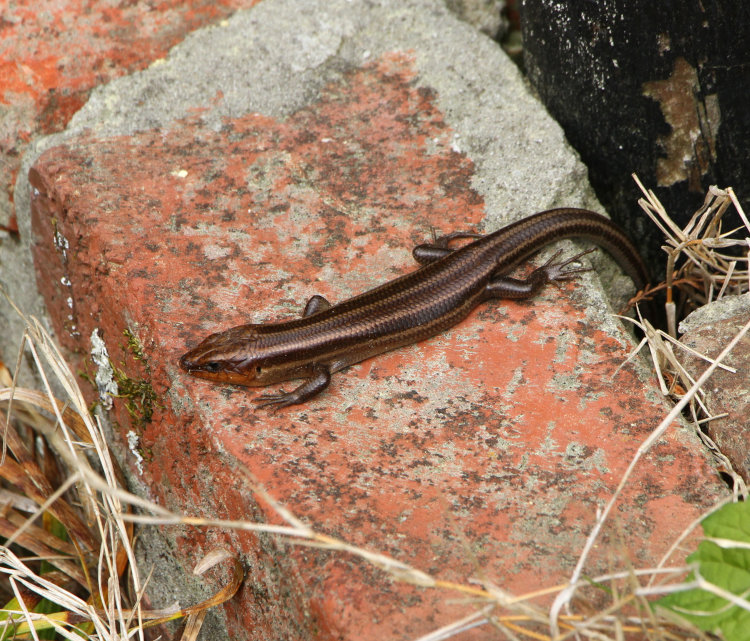
She’s a hefty specimen, big enough that I almost suspected she was a broad-headed skink instead, but I think we’re outside of their range here. The males will have more reddish heads, while the juveniles will generally sport higher contrast in their markings and an electric blue tail. Also, skinks are shiny and quite reflective, while anoles are not in the slightest. Since these photos, I’ve only gotten occasional glimpses of this one individual, yet a few others can be found around the property from time to time – just, not one-tenth as frequently as the anoles.
The anoles are also fond of sleeping in odd perches well above ground, at least when it’s warm enough, and this is enthusiastically evident when I venture out on the other side of the main pond, bordering The Bayou. Here, by the light of the headlamp, I can often see three or four from one spot.
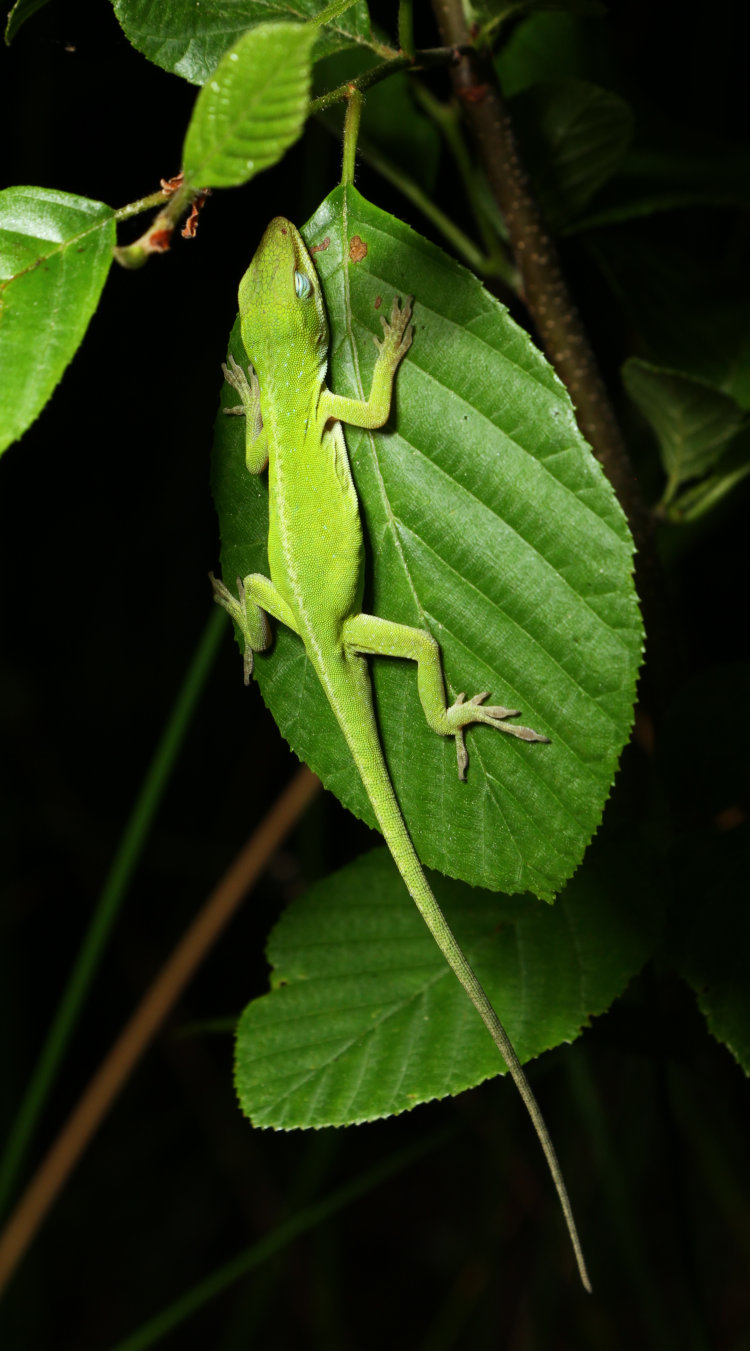
I’m always impressed by their ability to sleep confidently while clinging vertically, and this one is as vertical as it appears. I’m guessing that either they have a mechanism, like bird feet, that can keep certain muscles tensed even while asleep, or that their negligible weight can hang easily from single toenails dug into the leaves or bark. I mean, look at this: the toes aren’t even wrapped around anything. And no, it has nothing to do with moisture, because unlike the tree frogs, anoles are perfectly dry and in fact take cover at the first hint of rain, or even when I play the misting bottle over them, regardless of how hot and dry it’s been.
I kind of liked the perspective of this one:
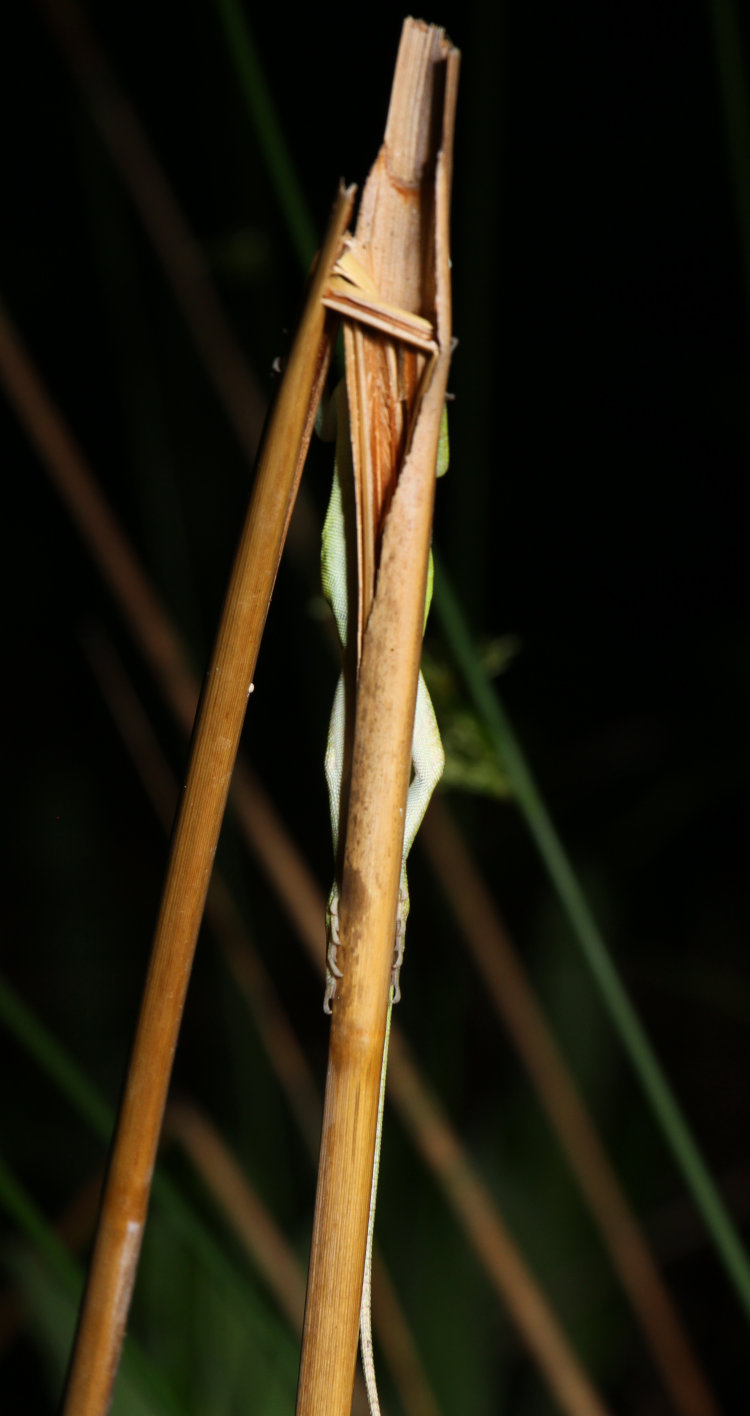
Can’t tell what the front feet are doing, but the backs hardly seem to be doing anything, so I doubt they’re supporting any weight. No matter what they’re perched on or what the conditions of the day were, anoles always seem to go as pale green as possible at night, though whether this serves a distinct purpose or is simply their ‘base’ relaxed coloration, I can’t say. I do know that they often collect dew overnight in the right conditions, presumably drinking it come morning, so perhaps this assists that somehow.
And then there’s this one:

The hind toes, at least, look like they might be hooked, but damn, I’d have a wicked headache in no time if I tried to sleep like that. When approaching with the headlamp, I will often see the anoles crack open their eyes, though honestly, I think it has more to do with how much noise I make than the light itself – I have plenty of pics where they never seem to notice the light, or even the bight bursts of the camera strobe.
This one noticed, but that was partially because I had to shift position for this perspective and couldn’t do so silently:
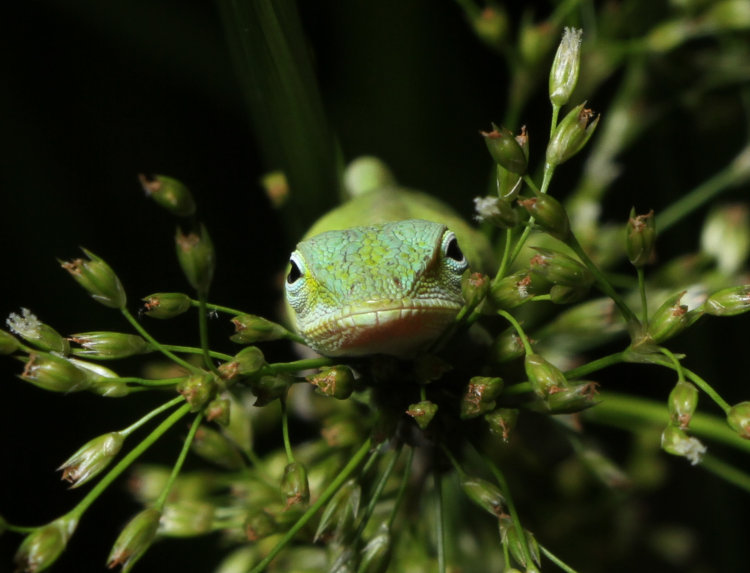
This one was comfortably horizontal, but on a plant that was surrounded by undergrowth and foliage, so not only was I unable to move quietly, I couldn’t even approach without something that I was trying to brush past disturbing the very plant that the anole was snoozing upon, causing it to sway slightly. Nonetheless, this was the extent of the reaction that I got from the anole, but we can perhaps credit the headlamp with that, since all they can likely see is the glare of the light and not me or the camera in any distinct manner. I waited patiently, and after less than a minute, the anole was dozing off again.
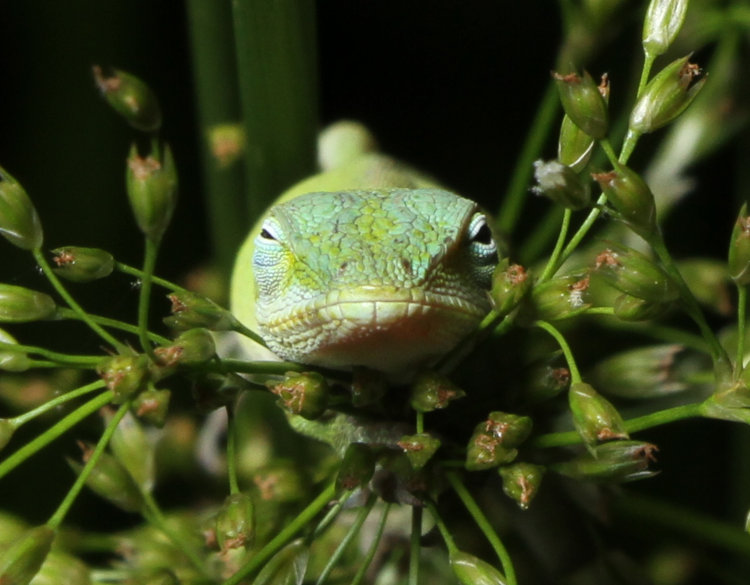
Now, if I touched one of them, they’d become much more alert and may scamper off, though whether they can actually see where they’re going at night is unknown to me; I can’t, at least without a light, so I can’t observe them to know how well they can. I’m inclined to say that their night vision is close to nonexistent, since plenty of tasty insects are active at night so it would be a prime feeding opportunity for them – provided the nights are warm enough, anyway, and that may only be a narrow range of time for them.
That’s a few pics down, and some of the older ones – we’re making progress, as long as I can maintain zero population growth for a little while at least. Plugging away…



















































